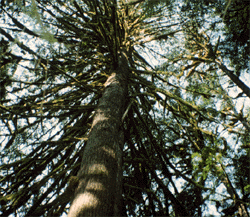 We
propose to quantify key energy pathways influencing the productivity of
salmonid streams in southeastern Alaska, and to determine how riparian
management and restoration activities affect these pathways. The project
will focus on salmonid-rearing (low-order) streams that differ in riparian
and forest communities. Streams will be chosen with three types of riparian
vegetation: second-growth alder-dominated, second-growth conifer-dominated,
and old-growth riparian. Comparisons of food-web
We
propose to quantify key energy pathways influencing the productivity of
salmonid streams in southeastern Alaska, and to determine how riparian
management and restoration activities affect these pathways. The project
will focus on salmonid-rearing (low-order) streams that differ in riparian
and forest communities. Streams will be chosen with three types of riparian
vegetation: second-growth alder-dominated, second-growth conifer-dominated,
and old-growth riparian. Comparisons of food-web  productivity
will be made among these three systems during the first phase of the study
(first 1-2 yr). In subsequent years, second-growth canopy thinning, developed
to be consistent with practical thinning regimes prescribed by Ranger Districts
within the Tongass National Forest, will occur at selected sites to study
short and long-term food-web productivity dynamics. Sampling protocols,
intensity and duration for this second long-term phase will hinge on future
funding.
productivity
will be made among these three systems during the first phase of the study
(first 1-2 yr). In subsequent years, second-growth canopy thinning, developed
to be consistent with practical thinning regimes prescribed by Ranger Districts
within the Tongass National Forest, will occur at selected sites to study
short and long-term food-web productivity dynamics. Sampling protocols,
intensity and duration for this second long-term phase will hinge on future
funding.
To Top